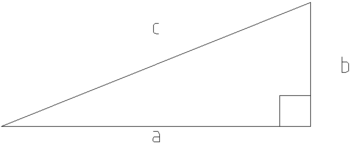Difference between revisions of "Pythagorean theorem"
(Merge and redirect. Needs cleanup, no time now, sorry...) |
|||
| Line 2: | Line 2: | ||
a^2 + b^2 = c^2 | a^2 + b^2 = c^2 | ||
| + | |||
| + | The Pythagorean Theorem was developed by the [[Greece|Greek]] mathematician [[Pythagoras]]. Is is a mathematical relationship between the lengths of the sides of a right triangle which can be illustrated as follows: | ||
| + | |||
| + | [[Image:Pythagorean_Theorem.png|left|350px|Pythagorean Theorem]] | ||
| + | |||
| + | <math>\to a^2+b^2=c^2</math> | ||
| + | |||
| + | |||
| + | Many different proofs of the Pythagorean theorem have been devised. Euclid's proof is one of the most complicated and least intuitive. | ||
| + | |||
| + | One "proof," below, appeared in an ancient manuscript with no explanation other than the word "look!" Can you see just by looking that the square on the hypotenuse and the two squares on the other sides must take up equal amounts of area? | ||
| + | |||
| + | [[image:Pythagoras.gif]] | ||
| + | |||
| + | [[Category:Geometry]] | ||
Revision as of 16:45, March 18, 2007
The Pythagorean theorem is possibly the most well known mathematical theorem. It states that by taking the square of each length of a right angled triangle and adding them together you will get the length of the hypotenuse squared. This is expressed mathematically as:
a^2 + b^2 = c^2
The Pythagorean Theorem was developed by the Greek mathematician Pythagoras. Is is a mathematical relationship between the lengths of the sides of a right triangle which can be illustrated as follows:

Many different proofs of the Pythagorean theorem have been devised. Euclid's proof is one of the most complicated and least intuitive.
One "proof," below, appeared in an ancient manuscript with no explanation other than the word "look!" Can you see just by looking that the square on the hypotenuse and the two squares on the other sides must take up equal amounts of area?

